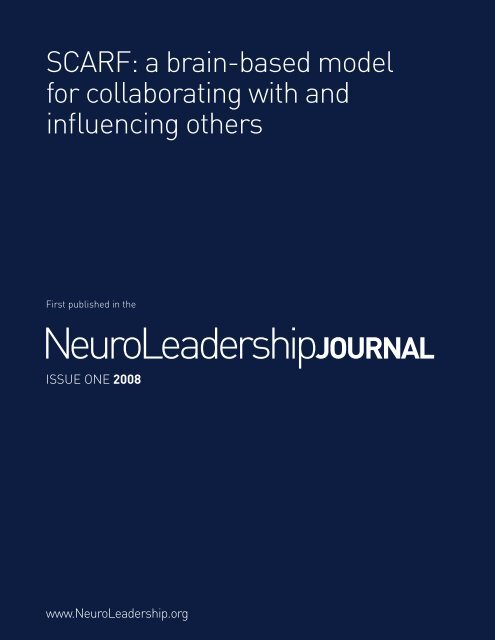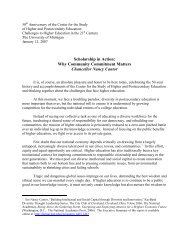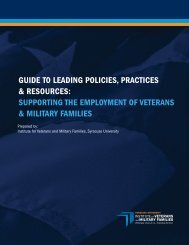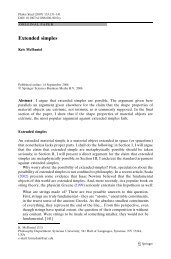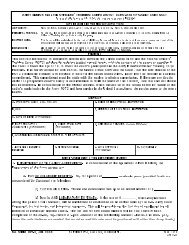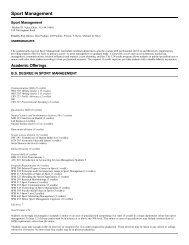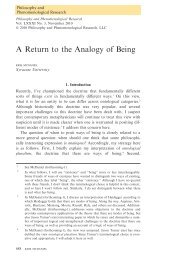SCARF - David Rock
SCARF - David Rock
SCARF - David Rock
- No tags were found...
Create successful ePaper yourself
Turn your PDF publications into a flip-book with our unique Google optimized e-Paper software.
<strong>SCARF</strong>: a brain-based modelfor collaborating with andinfluencing othersFirst published in theNeuroLeadershipjournalissue one 2008www.NeuroLeadership.org
Research<strong>SCARF</strong>: a brain-based modelfor collaborating with andinfluencing others<strong>David</strong> <strong>Rock</strong>CEO, Results Coaching Systems International, GPO Box 395, Sydney, NSW Australia 2001Faculty, CIMBACo-founder, NeuroLeadership InstituteEditor, NeuroLeadership Journaldavidrock@workplacecoaching.comIn a world of increasing interconnectedness and rapidchange, there is a growing need to improve the waypeople work together. Understanding the true drivers ofhuman social behavior is becoming ever more urgent inthis environment.The study of the brain, particularly within the field of social,cognitive and affective neuroscience is starting to providesome underlying brain insights that can be applied in thereal world (Lieberman, 2007). Social neuroscience exploresthe biological foundations of the way humans relate to eachother and to themselves and covers diverse topics that havea different degree to which they can be operationalized andunambiguously tested. Topics include: theory of mind, the self,mindfulness, emotional regulation, attitudes, stereotyping,empathy, social pain, status, fairness, collaboration, connectedness,persuasion, morality, compassion, deception, trustand goal pursuit.From this diversity, two themes are emerging from socialneuroscience. Firstly, that much of our motivation drivingsocial behavior is governed by an overarching organizingprinciple of minimizing threat and maximizing reward(Gordon, 2000). Secondly, that several domains of socialexperience draw upon the same brain networks to maximizereward and minimize threat as the brain networks used forprimary survival needs (Lieberman and Eisenberger, 2008). Inother words, social needs are treated in much the same wayin the brain as the need for food and water.The <strong>SCARF</strong> model summarizes these two themes within aframework that captures the common factors that can activatea reward or threat response in social situations. This model canbe applied (and tested) in any situation where people collaboratein groups, including all types of workplaces, educationalenvironments, family settings and general social events.The <strong>SCARF</strong> model involves five domains of humansocial experience: Status, Certainty, Autonomy, Relatednessand Fairness.Status is about relative importance to others. Certaintyconcerns being able to predict the future. Autonomy providesa sense of control over events. Relatedness is a sense ofsafety with others, of friend rather than foe. And fairness is aperception of fair exchanges between people.These five domains activate either the ‘primary reward’or ‘primary threat’ circuitry (and associated networks) ofthe brain. For example, a perceived threat to one’s statusactivates similar brain networks to a threat to one’s life. In thesame way, a perceived increase in fairness activates the samereward circuitry as receiving a monetary reward.The model enables people to more easily remember, recognize,and potentially modify the core social domains that drive humanbehavior. Labelling and understanding these drivers drawsconscious awareness to otherwise non conscious processes,which can help in two ways. Firstly, knowing the drivers that cancause a threat response enables people to design interactions tominimize threats. For example, knowing that a lack of autonomyactivates a genuine threat response, a leader or educator mayconsciously avoid micromanaging their employees or students.Secondly, knowing about the drivers that can activate a rewardresponse enables people to motivate others more effectively bytapping into internal rewards, thereby reducing the reliance onexternal rewards such as money. For example, a line managermight grant more autonomy as a reward for good performance.1
NeuroLeadershipJOURNALBefore exploring the domains of <strong>SCARF</strong> individually a briefcontext of the underlying science of the <strong>SCARF</strong> model, Namely,the approach (reward)-avoid (threat) response and the impactof this response on mental performance, is provided.Foundations of the Scarf modelThe approach (reward)-avoid (threat)response: a survival instinctAccording to Integrative Neuroscientist Evian Gordon, the‘minimize danger and maximize reward’ principle is anoverarching, organizing principle of the brain (Gordon, 2000).This central organizing principle of the brain is analogous toa concept that has appeared in the literature for a long time:the approach-avoid response. This principle represents thelikelihood that when a person encounters a stimulus theirbrain will either tag the stimulus as ‘good’ and engage inthe stimulus (approach), or their brain will tag the stimulusas ‘bad’ and they will disengage from the stimulus (avoid). Ifa stimulus is associated with positive emotions or rewards,it will likely lead to an approach response; if it is associatedwith negative emotions or punishments, it will likely lead toan avoid response. The response is particularly strong whenthe stimulus is associated with survival. Other concepts fromthe scientific literature are similar to approach and avoidanceand are summarized in the chart below.The approach-avoid response is a survival mechanism designedto help people stay alive by quickly and easily rememberingwhat is good and bad in the environment. The brain encodesone type of memory for food that tasted disgusting in the past,and a different type of memory for food that was good to eat.The amygdala, a small almond-shaped object that is partof the limbic system, plays a central role in rememberingwhether something should be approached or avoided. Theamygdala (and its associated networks) are believed to activateproportionally to the strength of an emotional response.The limbic system can processes stimuli before it reachesconscious awareness. One study showed that subliminallypresented nonsense words that were similar to threateningwords, were still categorized as possible threats by theamygdala (Naccache et al, 2005). Brainstem – Limbicnetworks process threat and reward cues within a fifth of asecond, providing you with ongoing nonconscious intuitionof what is meaningful to you in every situation of your dailylife (Gordon et al. Journal of Integrative Neuroscience, Sept2008). Such studies show that the approach-avoid responsedrives attention at a fundamental level – nonconsciously,automatically and quickly. It is a reflexive activity.It is easy to see that the ability to recognizing primaryrewards and threats, such as good versus poisonous food,would be important to survival and thus a part of the brain.Social neuroscience shows us that the brain uses similarcircuitry for interacting with the social world. Liebermanand Eisenberger explore this finding in detail in a paper inthis journal entitled ‘The Pains and Pleasures of Social Life’(Lieberman & Eisenberger, 2008).The effects of approaching versus avoidingThe significance of the approach-avoid response becomesclearer when one discovers the dramatic effect that thesestates can have on perception and problem solving, andthe implications of this effect on decision-making, stressmanagement,collaboration and motivation.In one study, two groups of people completed a paper mazethat featured a mouse in the middle trying to reach a picture onthe outside. One group had a picture of cheese on the outside,the other a predator – an owl. After completing the maze bothgroups were given creativity tests. The group heading towardsthe cheese solved significantly more creative problems thanthose heading to the owl (Friedman and Foster, 2001). Thisstudy, supported by several other similar studies, shows thateven subtle effects of this approach-avoid response can havea big impact on cognitive performance.Translating this effect to the social world, someone feelingthreatened by a boss who is undermining their credibility isless likely to be able to solve complex problems and morelikely to make mistakes. This reduced cognitive performance is2Response Synonyms in literature Which traditional primaryfactors activate the responseApproachAvoidAdvance, attack, reward,resource, expand, solution,strength, construct, engage.Withdraw, retreat, danger,threat, contract, problem,weakness, deconstruct.Rewards in form of money,food, water, sex, shelter,physical assets for survival.Punishment in the form ofremoval of money or otherresources or threats likea large hungry predatoror a gun.What social factors/situationsactivate the responseHappy, attractive faces.Rewards in the form ofincreasing status, certainty,autonomy, relatedness,fairness.Fearful, unattractive,unfamiliar faces. Threatsin the form of decreasingstatus, certainty, autonomy,relatedness, fairness.
esearchdriven by several factors. Firstly, when a human being sensesa threat, resources available for overall executive functionsin the prefrontal cortex decrease. There is a strong negativecorrelation between the amount of threat activation, and theresources available for the prefrontal cortex (Arnsten, 1998).The result is literally less oxygen and glucose available for thebrain functions involved in working memory, which impactslinear, conscious processing. When feeling threatened byone’s boss, it is harder to find smart answers because ofdiminished cognitive resources. Secondly, when threatened,the increased overall activation in the brain inhibits peoplefrom perceiving the more subtle signals required for solvingnon-linear problems, involved in the insight or ‘aha!”experience (Subramaniam et al, 2007). Thirdly, with theamygdala activated, the tendency is to generalize more, whichincreases the likelihood of accidental connections. There is atendency to err on the safe side, shrinking from opportunities,as they are perceived to be more dangerous. People becomemore likely to react defensively to stimuli. Small stressorsbecome more likely to be perceived as large stressors (Phelps,2006). When the boss appears threatening, perhaps they justdo not smile that day, suddenly a whole meeting can appearthreatening and the tendency can be to avoid taking risks.Clearly the threat or avoid response is not an ideal state forcollaborating with and influencing others. However, thisresponse is the default situation that often occurs in teams.Due to the overly vigilant amygdala, more tuned to threats thanrewards, the threat response is often just below the surfaceand easily triggered. Just speaking to one’s supervisor, orsomeone of higher status is likely to activate this response.Thus it is much easier to cause aggravation (activate anavoid response) than it is to help others think rationally andcreatively (the approach response). Many psychological andbrain studies now support this idea, showing that the avoidresponse generates far more arousal in the limbic system,more quickly and with longer lasting effects than an approachresponse (Beaumeister, 2001). This discovery that our brain isinherently attuned to threatening stimuli helps explain manydisquieting parts of life, from why the media focuses on badnews to why people are self-critical. It also points to the needto understand the social nature of the brain and proactivelyminimize common social threats.On the other hand, an approach response is synonymouswith the idea of engagement. Engagement is a state ofbeing willing to do difficult things, to take risks, to thinkdeeply about issues and develop new solutions. An approachstate is also closely linked to positive emotions. Interest,happiness, joy and desire are approach emotions. This stateis one of increased dopamine levels, important for interestand learning. There is a large and growing body of researchwhich indicates that people experiencing positive emotionsperceive more options when trying to solve problems(Frederickson, 2001), solve more non-linear problems thatrequire insight (Jung-Beeman, 2007), collaborate better andgenerally perform better overall.In summary, the <strong>SCARF</strong> model is an easy way to rememberand act upon the social triggers that can generate both theapproach and avoid responses. The goal of this model is tohelp minimize the easily activated threat responses, andmaximize positive engaged states of mind during attemptsto collaborate with and influence others.The <strong>SCARF</strong> modelWhile the five domains of the <strong>SCARF</strong> model appear to beinterlinked in many ways, there is also value in separating outand understanding each domain individually. Let’s look nowat some of the supporting research for each domain thenexplore how threats and rewards might be managed in each.StatusIn researcher Michael Marmot’s book The Status Syndrome:How Social Standing Affects Our Health and Longevity,Marmot makes the case that status is the most significantdeterminant of human longevity and health, even whencontrolling for education and income. This finding issupported by Sapolski’s work with primates (Sapolski, 2002).Sapolski found that in primate communities, status equalssurvival: higher status monkeys have lower baseline cortisollevels, live longer and are healthier.Status is about relative importance, ‘pecking order’ andseniority. Humans hold a representation of status in relationto others when in conversations, and this affects mentalprocesses in many ways (Zink, 2008). The brain thinksabout status using similar circuits for processing numbers(Chaio, 2003). One’s sense of status goes up when one feels‘better than’ another person. In this instance the primaryreward circuitry is activated, in particular the striatum,which increases dopamine levels. One study showed thatan increase in status was similar in strength to a financialwindfall (Izuma et al, 2008). Winning a swimming race, acard game or an argument probably feels good because ofthe perception of increased status and the resulting rewardcircuitry being activated.The perception of a potential or real reduction in statuscan generate a strong threat response. Eisenberger andcolleagues showed that a reduction in status resulting frombeing left out of an activity lit up the same regions of thebrain as physical pain (Eisenberger et al., 2003). While thisstudy explores social rejection, it is closely connected to theexperience of a drop in status.Reducing status threatIt can be surprisingly easy to accidentally threaten someone’ssense of status. A status threat can occur through givingadvice or instructions, or simply suggesting someone is3
NeuroLeadershipJOURNAL4slightly ineffective at a task. Many everyday conversationsdevolve into arguments driven by a status threat, a desireto not be perceived as less than another. When threatened,people may defend a position that doesn’t make sense, toavoid the perceived pain of a drop in status.In most people, the question ‘can I offer you some feedback’generates a similar response to hearing fast footsteps behindyou at night. Performance reviews often generate statusthreats, explaining why they are often ineffective at stimulatingbehavioral change. If leaders want to change others’ behavior,more attention must be paid to reducing status threats whengiving feedback. One way to do this is by allowing people togive themselves feedback on their own performance.Increasing status rewardOrganizations know all about using status as a rewardand many managers feel compelled to reward employeesprimarily via a promotion. This may have the unfortunate sideeffect of promoting people to the point of their incompetence.The research suggests that status can be increased in moresustainable ways. For example, people feel a status increasewhen they feel they are learning and improving and whenattention is paid to this improvement. This probably occursbecause individuals think about themselves using the samebrain networks they use for thinking about others (Mitchell,2006). For example, when beating one’s own best time at atask or sporting activity, the reward circuitry from a sense ofbeing ‘better than’ is activated, but in this case, the personone is ‘better than’ is oneself in the past.Many everydayconversationsdevolve intoarguments drivenby a status threat,a desire to not beperceived as lessthan another.Status can go up when people are given positive feedback,especially public acknowledgment. One study showedactivation of the reward circuitry in children being asstrong as money as when told ‘that’s correct’ by a repetitivecomputer voice. (Scott, Dapretto, et al., 2008, under review).Leaders can be afraid of praising their people for fear of therequest for promotion. However, given the deeply rewardingnature of status, giving positive feedback may reduce theneed for constant promotions, not increase it.Finally, status is about one’s relative position in a communityof importance such as a professional group or social clubbased on what is valued. While society, especially advertisingand the media, would have people spend money in order tobe ‘better than others’, it doesn’t have to be a zero-sumgame. Status can be increased without cost to others or aneffect on relatedness. As well as playing against oneself, onecan also change the community one focuses on, as whena low level mailroom clerk becomes the coach of a juniorbaseball team. Or, one can change what is important, forexample deciding that the quality of one’s work is moreimportant than the quantity of one’s work.CertaintyThe brain is a pattern-recognition machine that is constantlytrying to predict the near future. For example, the motornetwork is useless without the sensory system. To pick upa cup of coffee, the sensory system, sensing the position ofthe fingers at each moment, interacts dynamically with themotor cortex to determine where to move your fingers next.Your fingers don’t draw on fresh data each time; the braindraws on the memory of what a cup is supposed to feel likein the hand, based on expectations drawn from previousexperiences. If it feels different, perhaps slippery, youimmediately pay attention (Hawkins, 2004). The brain likesto know the pattern occurring moment to moment, it cravescertainty, so that prediction is possible. Without prediction,the brain must use dramatically more resources, involvingthe more energy-intensive prefrontal cortex, to processmoment-to-moment experience.Even a small amount of uncertainty generates an ‘error’response in the orbital frontal cortex (OFC). This takesattention away from one’s goals, forcing attention to theerror (Hedden, Garbrielli, 2006). If someone is not tellingyou the whole truth, or acting incongruously, the resultinguncertainty can fire up errors in the OFC. This is like having aflashing printer icon on your desktop when paper is jammed– the flashing cannot be ignored, and until it is resolved it isdifficult to focus on other things. Larger uncertainties, likenot knowing your boss’ expectations or if your job is secure,can be highly debilitating.The act of creating a sense of certainty is rewarding.Examples are everywhere in daily life: music that has simplerepeating patterns is rewarding because of the abilityto predict the flow of information. Meeting expectationsgenerates an increase in dopamine levels in the brain, areward response (Schultz, 1999). Going back to a wellknownplace feels good because the mental maps of theenvironment can be easily recalled.
esearchReducing the threat from uncertaintyAny kind of significant change generates uncertainty.Yet uncertainty can be decreased in many simple ways.This is a big part of the job of managers, consultants andleaders. As people build business plans, strategies, or mapout an organization’s structure, they feel increasing levelsof clarity about how an organization might better functionin the future. Even though it is unlikely things ever go asplanned, people feel better because certainty has increased.Breaking a complex project down into small steps doesthe same. Another key tool involves establishing clearexpectations of what might happen in any situation, as wellas expectations of desirable outcomes.Increasing the reward from certaintySome examples of how increase certainty include makingimplicit concepts more explicit, such as agreeing verbally howlong a meeting will run, or stating clear objectives at the startof any discussion. In learning situations, the old adage is ‘tellpeople what you are going to tell them, tell them, then tellthem what you told them’, all of which increases certainty.The perception of certainty can be increased even duringdeeply uncertain times. For example, when going throughan organizational restructure, providing a specific date whenpeople will know more information about a change may beenough to increase a sense of certainty. Much of the fieldof change management is devoted to increasing a sense ofcertainty where little certainty exists.AutonomyAutonomy is the perception of exerting control over one’senvironment; a sensation of having choices. Mieka (1985)showed that the degree of control organisms can exert overa stress factor determines whether or not the stressor altersthe organism’s functioning. Inescapable or uncontrollablestress can be highly destructive, whereas the same stressinterpreted as escapable is significantly less destructive.(Donny et al, 2006). The difference in some rodent studieswas life and death (Dworkin et al, 1995).An increase in the perception of autonomy feels rewarding.Several studies in the retirement industry find strongcorrelations between a sense of control and health outcomes(Rodin, 1986). People leave corporate life, often for far lessincome, because they desire greater autonomy.A reduction in autonomy, for example when being micromanaged, can generate a strong threat response. Whenone senses a lack of control, the experience is of a lack ofagency, or an inability to influence outcomes.Reducing autonomy threatWorking in a team necessitates a reduction in autonomy. Inhealthy cultures, this potential threat tends to be counteractedwith an increase in status, certainty and relatedness. With anautonomy threat just below the surface, it can be helpful topay attention to this driver. The statement ‘Here’s two optionsthat could work, which would you prefer?’ will tend to elicit abetter response than ‘Here’s what you have to do now’.Increasing rewards from autonomyProviding significant autonomy in an organization can bedifficult. Yet even a subtle perception of autonomy can help,for example by having self-directed learning portals, whereemployees get to design their learning curriculum, and selfdrivenhuman resource systems.Allowing people to set up their own desks, organize theirworkflow, even manage their working hours, can all bebeneficial if done within agreed parameters. Sound policyestablishes the boundaries within which individuals canexercise their creativity and autonomy. Sound policy shouldenable individual point-of-need decision-making withoutconsultation with, or intervention by, leaders. In this regard,sound policy hard-wires autonomy into the processesof an organization.RelatednessRelatedness involves deciding whether others are ‘in’ or‘out’ of a social group. Whether someone is friend, or foe.Relatedness is a driver of behavior in many types of teams,from sports teams to organizational silos: people naturallylike to form ‘tribes’ where they experience a sense ofbelonging. The concept of being inside or outside the groupis probably a by-product of living in small communities formillions of years, where strangers were likely to be troubleand should be avoided.In the absenceof safe socialinteractions thebody generates athreat response…The decision that someone is friend or foe happens quicklyand impacts brain functioning (Carter & Pelphrey, 2008).For example, information from people perceived as ‘like us’is processed using similar circuits for thinking one’s ownthoughts. When someone is perceived as a foe, differentcircuits are used (Mitchell, 2006). Also, when treating someoneas a competitor, the capacity to empathise drops significantly(Singer et al, 2006).5
NeuroLeadershipJOURNAL6Neuroscientist John Cacioppo talks about the need for safehuman contact being a primary driver, like the need for food(Cacioppo, 2008). In the absence of safe social interactionsthe body generates a threat response, also known as feelinglonely. However, meeting someone unknown tends togenerate an automatic threat response. This explains whyone feels better at a party knowing three people rather thanone. Alcohol helps to reduce this automatic social threatresponse, enabling strangers to communicate more easily,hence its use as a social lubricant the world over. In theabsence of alcohol, getting from foe to friend can be helpedby an oxytocin response, an experience of connecting with theother person. Oxytocin is a hormone produced naturally inthe brain, and higher levels of this substance are associatedwith greater affiliative behavior (Domes et al, 2007). Studieshave shown far greater collaboration when people are givena shot of oxytocin, through a nasal spray. (Kosfield, 2005).A handshake, swapping names and discussing somethingin common, be it just the weather, may increase feelingof closeness by causing the release of oxytocin (Zak et al,2005). The concept of relatedness is closely linked to trust.One trusts those who appear to be in your group, who onehas connected with, generating approach emotions. Andwhen someone does something untrustworthy, the usualresponse is to withdraw. The greater that people trustone another, the stronger the collaboration and the moreinformation that is shared.Reducing threats from lack of relatednessIncreasing globalization highlights the importance ofmanaging relatedness threats. Collaboration between peoplefrom different cultures, who are unlikely to meet in person,can be especially hard work. The automatic foe responsedoes not get diminished by social time together. This responsecan be mitigated by dedicating social time in other forms.For example, using video to have an informal meeting, orensuring that people forming teams share personal aspectsof themselves via stories, photos or even social-networkingsites. In any workplace it appears to pay off well to encouragesocial connections. A Gallup report showed that organizationsthat encourage ‘water cooler’ conversations increasedproductivity (Gallup, November 2008).Increasing the rewards from relatednessPositive social connections are a primary need; however,the automatic response to new social connections involvesa threat. To increase the reward response from relatedness,the key is to find ways to increase safe connections betweenpeople. Some examples include setting up clearly definedbuddy systems, mentoring or coaching programs, or smallaction learning groups. Small groups appear to be safer thanlarge groups. The Gallup organizations research on workplaceengagement showed that the statement ‘I have a best friendat work’ was central to engagement in their ‘Q12’ assessment(Gallup Organization). Perhaps even having one trustingrelationship can have a significant impact on relatedness.FairnessStudies by Golnaz Tabibnia and Matthew Lieberman at UCLAshowed that 50 cents generated more of a reward in thebrain than $10.00, when it was 50 cents out of a dollar, andthe $10 was out of $50 (Tabibnia & Lieberman, 2007). Thisstudy and a number of others illustrate that fair exchangesare intrinsically rewarding, independent of other factors. Theneed for fairness may be part of the explanation as to whypeople experience internal rewards for doing volunteer workto improve their community; it is a sense of decreasing theunfairness in the world.Unfair exchanges generate a strong threat response(Tabibnia & Lieberman, 2007). This sometimes includesactivation of the insular, a part of the brain involved inintense emotions such as disgust. Unfair situations maydrive people to die to right perceived injustices, such as inpolitical struggles. People who perceive others as unfairdon’t feel empathy for their pain, and in some instances,will feel rewarded when unfair others are punished (Singeret al, 2006).Reducing the threat from unfairness and increasingthe reward from fairnessA threat response from a sense of unfairness can be triggeredeasily. The following statements are examples of whatemployees might say in reaction to a threat to fairness:• ‘He has a different set of rules for Mike and Sally than forthe rest of us.’• ‘Management tell us that we need to lose headcount, butour sales are carrying the other division and they don’thave to cut anyone.’• ‘They do all this talk about ‘values’ but it’s business asusual at the top.’The threat from perceived unfairness can be decreasedby increasing transparency, and increasing the level ofcommunication and involvement about business issues. Forexample, organizations that allow employees to know detailsabout financial processes may have an advantage here.Establishing clear expectations in all situations – from a onehourmeeting to a five-year contract – can also help ensurefair exchanges occur. A sense of unfairness can result froma lack of clear ground rules, expectations or objectives.Allowing teams to identify their own rules can also help. Inan educational context, a classroom that creates the rulesof what is accepted behavior is likely to experience lessconflict. Examples of the success of self-directed teams inmanufacturing abound (Semler, 1993). Much of what theseself-driven teams do is ensure fairness in grass-rootsdecisions, such as how workloads are shared and who cando which tasks.
esearchThe issue of pay discrepancies in large organizations is achallenging one, and many employees are deeply unhappyto see another person working similar hours earning 100times their salary. Interestingly, it is the perception offairness that is key, so even a slight reduction in seniorexecutive salaries during a difficult time may go a long wayto reducing a sense of unfairness.The wider implications of the Scarf modelManaging oneselfThe <strong>SCARF</strong> model helps individuals both minimize threatsand maximize rewards inherent in everyday experience. Forminimizing threats, knowing about the domains of <strong>SCARF</strong>helps one to label and reappraise experiences that mightotherwise reduce performance. Labelling (Liebermanet al, 2007) and reappraisal (Ochsner & Gross, 2005) arecognitive tools that have been verified in brain studies to beeffective techniques for reducing the threat response. Thesetechniques have been shown to be more effective at reducingthe threat response than the act of trying to suppress anemotion (Goldin et al, 2007). Knowing about the elementsof <strong>SCARF</strong> helps one understand issues such as why youcan’t think clearly when someone has attacked your status,instead of just trying to push the feeling aside.Knowing the domains of <strong>SCARF</strong> also allows an individualto design ways to motivate themselves more effectively. Anexample might be focusing attention on increasing one’ssense of autonomy during a time of uncertainty, suchas focusing on the thrill of doing whatever you like whensuddenly out of work.Education and trainingSuccessful educators, trainers and facilitators intuitively usethe <strong>SCARF</strong> model. They know that people learn best whenthey are interested in something. Interest is an approach state.Teaching children who feel threatened, disconnected, sociallyrejected or treated unfairly is an uphill battle. For example,educators can create a nurturing learning environment bypointing out specifically how people are improving, whichincreases a sense of status. This is particularly important whenlearning anything new, which can create a threat response.Educators can also create certainty by presenting clearoutlines of what is being learned, and provide a perceptionof some autonomy by introducing choice into the classroom.The key here is for educators, trainers and coaches to valuethe approach state as the necessary state for learning, and toput effort and attention into maintaining this toward state.CoachingPersonal and executive coaching can increase all five <strong>SCARF</strong>domains. Status can be increased through regular positivefeedback, attention to incremental improvements, and theachievement of large goals. Certainty can be increasedby identifying central goals, and subsequently reducingthe uncertainty inherent in maintaining multiple focuses.Breaking down large goals into smaller steps increasescertainty about how a goal can be reached. Finding waysto take action when challenges appear insurmountablecan increase autonomy. Relatedness can be increasedthrough the relationship with the coach. Fairness can bereduced through seeing situations from other perspectives.The <strong>SCARF</strong> model helps explain why coaching can beso effective at facilitating change, and points to ways ofimproving its delivery.The <strong>SCARF</strong> modelpoints to morecreative ways ofmotivating thatmay not just becheaper, but alsostronger and moresustainable.Leadership developmentThe <strong>SCARF</strong> model provides a robust scientific framework forbuilding self-awareness and awareness of others amongstleaders. Many new leaders may negatively impact thedomains of <strong>SCARF</strong> by accident. They may know how thingsshould be done, and subsequently provide too much directionand not enough positive feedback, thereby affecting people’sstatus. They often don’t provide clear expectations, impactingcertainty. They micro manage, impacting autonomy. They wantto maintain a professional distance, impacting relatedness.And, they may impact fairness by not being transparentenough. When the opposite happens and you meet someonewho makes you feel better about yourself, provides clearexpectations, lets you make decisions, trusts you and is fair,you will probably work harder for them as you feel intrinsicallyrewarded by the relationship itself. Spending time around aleader like this activates an approach response and opensup people’s thinking, allowing others to see information theywouldn’t see in an avoid state.Organizational systems<strong>SCARF</strong> has many implications for how organizations arestructured, including reward systems, communicationssystems, decision processes, information flow and7
NeuroLeadershipJOURNAL8remuneration structures. In the space available in this articlewe will explore just one of these – reward systems. Techniquesfor motivating and rewarding staff are largely based on the carrotand stick principle, with the carrot mostly involving money or apromotion. The <strong>SCARF</strong> model points to more creative ways ofmotivating that may not just be cheaper, but also stronger andmore sustainable. For example, success could be rewarded byincreasing people’s autonomy by allowing them to have greaterflexibility in their work hours. Or, rewards could be providedvia increasing the opportunity for learning new skills, whichcan increase a sense of status. Or, people could be rewardedthrough increasing relatedness through allowing more time tonetwork with peers during work hours.SummaryWhile the five domains of <strong>SCARF</strong> reflect core brain networksof greatest significance when it comes to collaborating withand influencing others. Understanding these drivers can helpindividuals and organizations to function more effectively,reducing conflicts that occur so easily amongst people, andincreasing the amount of time people spend in the approachstate, a concept synonymous with good performance.Understanding the domains in the <strong>SCARF</strong> model andfinding personalized strategies to effectively use these braininsights, can help people become better leaders, managers,facilitators, coaches, teachers and even parents.In the early 2000s, the philosopher Theodore Zeldin said,‘When will we make the same breakthroughs in the way wetreat each other as we have made in technology?’ Thesefindings about the deeply social nature of the brain, and thedeep relevance of the domains of <strong>SCARF</strong> in everyday life,may provide some small steps in the right direction.Suggestions for future researchAn abbreviated list of potential research issues includes thefollowing questions:• Which of the domains of <strong>SCARF</strong> generate the strongestthreats or rewards?• Which domains have the longest-term impact?• What are the links between the domains?• How can studies be designed to identify individualdomains?• What are the best techniques for minimizing threat andmaximizing reward in each of the domains?• Do people vary in the importance of the 5 domains, andif so are there patterns across men and women, agegroups or cultures?• Is there value in assessing these domains in individualsor culturally in organizations?• What are the organizational implications of this modelfor how systems are set up?• Testing what aspects of the model are most effective towhich individual leaders?AcknowledgmentsThis article was written with the help of several reviewers,including Rachel Sheppard, Dr. Evian Gordon Joanne Caprittiand Karen Jayne Eyre. I am grateful to the dozens of interviewswith many of the scientists referenced for their input as well,with special thanks to Dr. Jeffrey M. Schwartz, Dr. MatthewLieberman, Dr. Mark Jung-Beeman and Dr. Yi-Yuan Tang fortheir informal mentoring over recent years on these topics.ReferencesArnsten, A. F. T. (1998). The Biology of Being Frazzled.Science, 280, 1711-1712.Baumeister, R. F., Bratslavsky, E., &Vohs, K.D. (2001). BadIs Stronger Than Good. Review of General Psychology, 5(4),323-370.Baumeister, R. F. & Leary, M. R. (1995). The need to belong:Desire for interpersonal attachments as a fundamentalhuman motivation. Psychological Bulletin, 117, 497-529.Cacioppo, J. T., & Patrick, B. (2008). Loneliness: humannature and the need for social connection. New York: W. W.Norton and Company.Carter, E. J. & Pelphrey, K. A., (2008). Friend or foe?Brain systems involved in the perception of dynamic signalsof menacing and friendly social approaches. JournalSocial Neuroscience, Volume 3, Issue 2 June 2008 , pages151-163.Chiao, J. Y., Bordeaux, A. R., Ambady, N. (2003). Mentalrepresentations of social status. Cognition, 93, 49-57.Domes , G., Heinrichs, M., Gläscher J., Büchel, C., Braus,D., Herpertz, S. (2007). Oxytocin Attenuates AmygdalaResponses to Emotional Faces Regardless of Valence.Biological Psychiatry, 62(10), 1187-1190.Donny, E. C., Bigelow, G. E., & Walsh S. L. (2006). Comparingthe physiological and subjective effects of self-administeredvs yoked cocaine in humans. Psychopharmacology, 186(4),544-52.Dworkin, S I., Mirkis, S., Smith J. E. (1995). Responsedependentversus response-independent presentationof cocaine: differences in the lethal effects of the drug.Psychopharmacology, 117(3), 262-266.Eisenberger, N. I., Lieberman, M. D., & Williams, K. D. (2003).Does rejection hurt? An fMRI study of social exclusion.Science, 302, 290-292.Fredrickson, B. L. (2001). The Role of Positive Emotionsin Positive Psychology: The Broaden-and-Build Theory ofPositive Emotions. American Psychologist, 56, 218-226.Friedman R. and Foster J. (2001). The effects of promotionand prevention cues on creativity. Journal of Personality andSocial Psychology, 81, 1001-1013.
esearchGallup, 13 November 2008, Newsflash: Workplace SocializingIs Productive Gallup Organization. Employee Engagement.Retrieved November 20, 2009 http://www.gallup.com/consulting/52/Employee-Engagement.aspxGilbert, D. (2006). Stumbling upon happiness. KnopfPublishing Group.Goldin, P. R., McRae, K., Ramel, W., & Gross, J. J. (2007).The Neural Bases of Emotion Regulation: Reappraisal andSuppression of Negative Emotion, Biological Psychiatry, 63,577-586.Gordon, E. (2000). Integrative Neuroscience: Bringingtogether biological, psychological and clinical models of thehuman brain. Singapore: Harwood Academic Publishers.Gordon, E. et al. (2008), An “Integrative Neuroscience”platform: application to profiles of negativity and positivitybias, Journal of Integrative Neuroscience.Hawkins, J. & Blakeslee, S. (2004). On Intelligence. TimesBooks.Hedden, T., & Gabrieli, J. D. E. (2006). The ebb and flowof attention in the human brain. Nature Neuroscience, 9,863-865.Izuma, K., Saito, D., Sadato, N. (2008). Processing of Socialand Monetary Rewards in the Human Striatum. Neuron,58(2), 284-294.Kosfeld, M. Heinrichs, M., Zak, P. J., Fischbacher, U., & Fehr,E. (2005). Oxytocin increases trust in humans. Nature, 435,673-676.Lieberman, Eisenberger, Crockett, Tom, Pfeifer, & Way(2007). Putting Feelings Into Words: Affect LabellingDisrupts Amygdala Activity in Response to Affective Stimuli.Psychological Science, 18(5), 421-428.Lieberman & Eisenberg (2008) The pains and pleasures ofsocial life, NeuroLeadership Journal, Edition 1.Eisenberger & Lieberman (2004). Why it hurts to be left out:The neurocognitive overlap between physical and socialpain. Trends in Cognitive sciences, 8, 294-300.Jung Beeman, M., (2007), presented at the firstNeuroLeadership Summit, Asolo, Italy.Lieberman, M. D. (2007). Social Cognitive Neuroscience:A Review of Core Processes. Annual Review of Psychology,58, 259-289.Mason, M. F., Norton, M. I., Van Horn, J. D., Wegner, D. M.,Grafton, S. T., & Macrae, C. N. (2007). Wandering minds:the default network and stimulus-independent thought.Science, 315, 393-395.Mather, M., Mitchell, K. J., Raye, C. L., Novak, D. L., Greene,E.J., & Johnson, M. K. (2006). Emotional Arousal Can ImpairFeature Binding in Working Memory. Journal of CognitiveNeuroscience, 18, 614-625.Mineka, S. & Hendersen, R. W. (1985). Controllability andpredictability in acquired motivation. Annual Review ofPsychology, 36, 495-529.Mitchell, J. P., Macrae, C. N., & Banaji, M. R. (2006).Dissociable Medial Prefrontal Contributions to Judgmentsof Similar and Dissimilar Others. Neuron, 50, 655-663.Naccache, L., Gaillard, R.L., Adam, C., Hasboun, D.,Clemenceau, S., Baulac, M., Dehaene, S., & Cohen, L.(2005). A direct intracranial record of emotions evoked bysubliminal words. Proceedings of the National Academy ofScience, 102, 7713-7717.Ochsner, K. N., & Lieberman, M. D. (2001). The emergenceof social cognitive neuroscience. American Psychologist, 56,717-734.Ochsner K. N., & Gross, J. J. (2005). The cognitive control ofemotion. Trends in Cognitive Sciences, 9(5), 242-249.Phelps, E. A. (2006). Emotion and cognition: Insightsfrom Studies of the Human Amygdala. Annual Review ofPsychology, 57, 27-53.Rodin, J. (1986). Aging and health: effects of the sense ofcontrol. Science, 233, 1271-1276.Sapolski, R.M. (2002). A Primate’s Memoir: A Neuroscientist’sUnconventional Life Among the Baboons. Scribner.Schultz, W. (1999). The Reward Signal of Midbrain DopamineNeurons. News in Physiological Sciences, 14(6), 249-255.Scott, Dapretto, et al., under review (2008), Social Cognitiveand Affective Neuroscience Journal.Semler, R. (1993). Maverick: The Success Story behind theWorld’s Most Unusual Workplace. Warner Books.Seymour, B., Singer, T., & Dolan, R. (2007). The neurobiologyof punishment. Nature Reviews Neuroscience, 8, 300-311.Singer, T., Seymour, B., O’Doherty, J.P., Stephan, K.E.,Dolan, R.J., Frith, C.D., 2006. Empathic neural responsesare modulated by the perceived fairness of others. Nature,439, 466-469.Subramaniam, K., Kounios, J., Bowden, E.M., Parrish, T.B.,& Jung-Beeman, M. (In press 2008). Positive mood andanxiety modulate anterior cingulate activity and cognitivepreparation for insight. Journal of Cognitive Neuroscience.Tabibnia, G., & Lieberman M. D. (2007). Fairness andCooperation Are Rewarding: Evidence from Social CognitiveNeuroscience. Annals of the New York Academy of Sciences,1118, 90-101.Zak, P. J., Kurzban, R., Matzner, W. T. (2005). Oxytocin isassociated with human trustworthiness, Hormones andBehavior, 48(5), 522-527.Zink, C. F., Tong, Y., Chen, Q., Bassett, D. S., Stein, J. L., & Meyer-Lindenberg A. (2008). Know Your Place: Neural Processing ofSocial Hierarchy in Humans. Neuron, 58, 273-283.9


